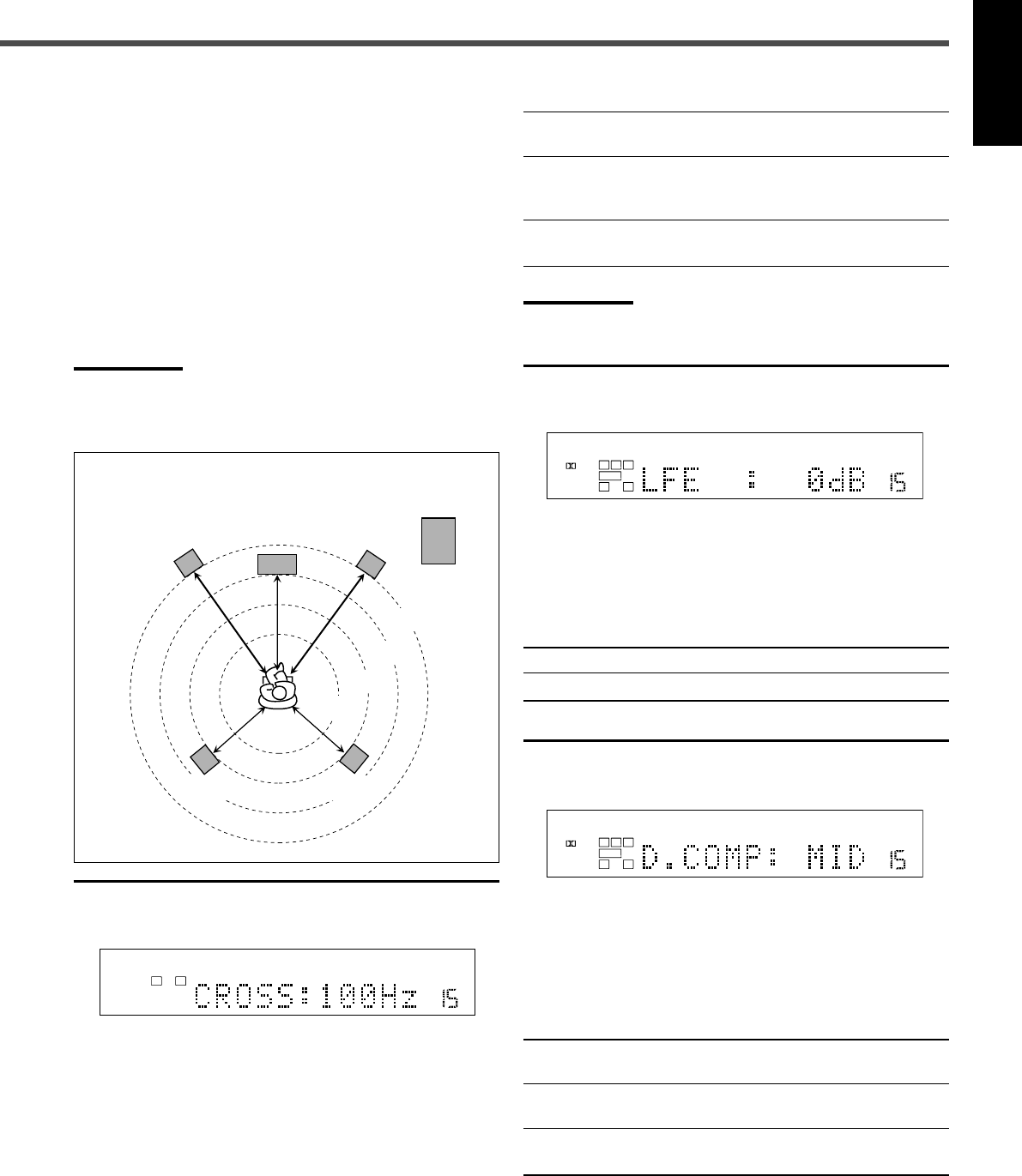
24
English
8 ft
(2.4 m)
9 ft
(2.7 m)
10 ft
(3.0 m)
11 ft
(3.3 m)
Left front
speaker
Right front
speaker
Right surround
speaker
Subwoofer
Left surround
speaker
Center speaker
The distance from your listening point to the speakers is
another important element to obtain the best possible
surround sound from the Surround modes.
Set the distance from your listening point to the speakers. By
referring to the speaker distance setting, this unit
automatically sets the delay time of the sound through each
speaker so that sounds through all the speakers can reach
you at the same time.
• If you have used Quick Setup (see page 21), this setting is
not required.
Set the distance from the listening point within the range of
0.3 m (1 ft) to 9.0 m (30 ft), in 0.3 m (1 ft) intervals.
Notes:
•“10ft” is the initial setting.
• If you have selected “NO” for the center and surround speakers
setting, you cannot set the speaker distance for the center and
surround speakers.
Ex.:In this case, set “FRNT D” to “11ft,”
set “CNTR D” to “10ft” and
set “SURR D” to “9ft.”
7 Crossover frequency
“CROSS”
Small speakers cannot reproduce the bass sounds efficiently.
If you use a small speaker in any position, this unit
automatically reallocates the bass sound elements assigned
to the small speaker to the large speakers.
To use this function properly, set the crossover frequency
level according to the size of the small speaker connected.
• If you have selected “LRG (large)” for all speakers, this
function will not take effect.
Select one of the following settings:
80Hz Select when the cone speaker unit built in the
speaker is about 12 cm (4
3
/4 inches).
100Hz Select when the cone speaker unit built in the
speaker is about 10 cm (3
15
/16 inches) (initial
setting).
120Hz Select when the cone speaker unit built in the
speaker is about 8 cm (3
3
/16 inches).
Note:
• Crossover frequency is not valid for the HEADPHONE mode.
7 Low frequency effect attenuator
“LFE”
If the bass sound is distorted while playing back software
encoded with Dolby Digital or DTS, set the LFE level to
eliminate distortion.
• This function takes effect only when LFE signals come in.
Select one of the following settings:
0dB Normally select this (initial setting).
–10dB Select when the bass sound is distorted.
7 Dynamic range compression
“D.COMP”
You can compress the dynamic range (difference between
maximum sound and minimum sound) of the reproduced
sound. This is useful when enjoying surround sound at night.
• This function takes effect only when playing back a source
encoded with Dolby Digital.
Select one of the following settings:
MID Select when you want to reduce the dynamic
range a little (initial setting).
MAX Select when you want to apply the compression
effect fully. (Useful at night.)
OFF Select when you want to enjoy surround with its full
dynamic range. (No effect applied.)
MPEG-2AAC
TA NEWS INFO
ANALOG
S
DIGITAL AUTO DSP SLEEP REPEAT RANDOM RDS INPUT ATT
SPK 1 2
AUTO MODE
A.POSITION
PROGRESSIVE1A-B
DIGITAL
LPCM
LFE
PPCM AUTO
SURROUND
GROUP TITLE TRACK CHAP.
RESUME
kHz
MHz
VOL
BONUSB.S.P TUNED STEREO AUTO MUTING
PL
SUBWFR
LCR
LS RS
PROGRAM
REC
MPEG-2AAC
TA NEWS INFO
ANALOG
S
DIGITAL AUTO DSP SLEEP REPEAT RANDOM RDS INPUT ATT
SPK 1 2
AUTO MODE
A.POSITION
PROGRESSIVE1A-B
DIGITAL
LPCM
LFE
PPCM AUTO
SURROUND
GROUP TITLE TRACK CHAP.
RESUME
kHz
MHz
VOL
BONUSB.S.P TUNED STEREO AUTO MUTING
PL
SUBWFR
LCR
LS RS
PROGRAM
REC
MPEG-2AAC
TA NEWS INFO
ANALOG
S
DIGITAL AUTO DSP SLEEP REPEAT RANDOM RDS INPUT ATT
SPK 1 2
AUTO MODE
A.POSITION
PROGRESSIVE1A-B
DIGITAL
LPCM
LFE
PPCM AUTO
SURROUND
GROUP TITLE TRACK CHAP.
RESUME
kHz
MHz
VOL
BONUSB.S.P TUNED STEREO AUTO MUTING
PL
SUBWFR
L C R
LS RS
PROGRAM
REC
21-27_RX-DV31SL[C]f.p65 03.12.18, 15:0724


















